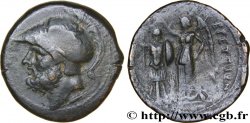v32_0828 - SALUVII Hémiobole à la tête de satyre et à la corne
MONNAIES 32 (2007)
Starting price : 280.00 €
Estimate : 450.00 €
unsold lot
Starting price : 280.00 €
Estimate : 450.00 €
unsold lot
Type : Hémiobole à la tête de satyre et à la corne
Date: après 49 avant J.-C.
Metal : silver
Diameter : 8,5 mm
Orientation dies : 7 h.
Weight : 0,37 g.
Rarity : R3
Coments on the condition:
Monnaie de qualité exceptionnelle, surtout sur un flan si large et avec un frappe si vigoureuse. Malheureusement, la tête est partiellement tachée, avec un aspect hétérogène du métal. Sinon, agréable patine finement grisée avec une tache sombre au revers
Obverse
Obverse legend : ANÉPIGRAPHE.
Obverse description : Tête masculine à droite.
Reverse
Reverse legend : ANÉPIGRAPHE.
Reverse description : Une sorte du virgule.
Commentary
Cette rare obole manque à tous les musées consultés. Cet exemplaire est très proche du n° 96 de MONNAIES II. Le n° 539 vendu dans MONNAIES XXVI l'a été à 366€ sur un ordre de 1001€ !
Ce monnayage pourrait constituer une dégénérescence de l'obole CABE LEPI à la corne d'abondance.
Ce monnayage pourrait constituer une dégénérescence de l'obole CABE LEPI à la corne d'abondance.








 Report a mistake
Report a mistake Print the page
Print the page Share my selection
Share my selection Ask a question
Ask a question Consign / sell
Consign / sell
 Full data
Full data















